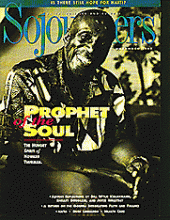It was a frigid Christmas Eve in Washington, D.C. A lone oboe played haunting renditions of Christmas songs in the night air of Lafayette Park, where dozens of homeless men and women live just across Pennsylvania Avenue from the White House.
Jim and I had just left the Christmas Eve celebration at Sojourners, where the children had set up our large Salvadoran-style Nativity set on bales of hay. Carols were sung, and candles flickered, making long shadows on the walls and creating an aura of warmth and security. In the park, people huddled closely and stomped their feet to keep warm. We shared warm bread and fruit from the abundance of the simple feast that had followed our worship.
From the park we drove uptown to the Washington Cathedral, where the music of several choirs was filling the sanctuary. The massive church was warm, ornately decorated for the season, and packed with a throng of people dressed in their Christmas best. By the time we arrived, there was standing room only, under some fragrant pine boughs in the back.
It was nearing midnight as we drove back across the city. We began searching for a restaurant that might be open at such an hour. The owner of an Italian cafe was taking the "OPEN" sign out of his window as we pulled up. We gently pleaded with him, and he said finally, "Well, there are two pieces of lasagna left."
The cafe's television was tuned to the Christmas Mass at St. Peter's Cathedral in Rome, where it was already Christmas morning. The owner put up the "CLOSED" sign and joined us. He commented on the beauty of the Mass's pageantry, as a long parade of children from every nation of the world walked forward to receive a blessing from the Pope.
Read the Full Article
